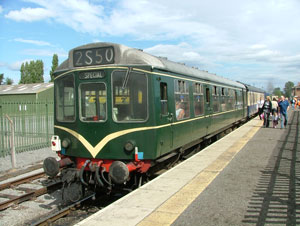Wensleydale Railway
 The Wensleydale Railway is a 22 mile line on a 99 year lease to preservationists, made possible by the reduction or elimination of the previous MOD and stone traffic that kept the line open latterly. The line was initially opened for 16 miles between Leeming Bar and Redmire (with another three intermediate stations) with the stock storage, facilities and headquarters all located at Leeming Bar. Later, the remaining 6 miles was opened to a new station at Northallerton West, close to their mainline connection with the East Coast Mainline.
The Wensleydale Railway is a 22 mile line on a 99 year lease to preservationists, made possible by the reduction or elimination of the previous MOD and stone traffic that kept the line open latterly. The line was initially opened for 16 miles between Leeming Bar and Redmire (with another three intermediate stations) with the stock storage, facilities and headquarters all located at Leeming Bar. Later, the remaining 6 miles was opened to a new station at Northallerton West, close to their mainline connection with the East Coast Mainline.
The line was once a through route linking Northallerton with Garsdale, and the railway has long term plans to reinstate the remaining 18 miles of missing track.
The railway is a relative newcomer with the first trains running between Leeming Bar and Leyburn in 2003, extending to Redmire a year later. DMUs were used for the first trains and ran a large number of their earlier services, although there was steadily a rise in diesel loco haulage as well as regular steam services during the summer months. The dominance of air braked coaching stock on the line at that time saw the DMUs used further during the summer as a vacuum braked set for steam operations.
Both privately owned and railway owned vehicles ran on the line, which since opening has seen classes 101, 107, 108, 110, 117 & 121 used. The community rail ethos of the line, coupled to its long length, required that the DMUs be frequently used, often daily. By the 2010's, this had taken its toll on the first generation fleet, most of which was withdrawn from service and in storage. By 2020 only a single unit was still in service.
In 2020 the railway opened a new chapter with the preservation and operation of nine second generation Class 142 sets, a Class 143 and a Class 144. Around the same time several of the first generation vehicles were put up for sale.
The line currently has the most preserved second generation railcars on a single heritage railway. They have future plans to consolidate the collection with fewer resident first generation sets but maintained in operational condition, supported by the new second generation fleet, as part of an integrated traction policy covering all types of vehicle in their collection going forwards as the railway contionues to develop.